This record is provided by CoinArchives, a database of numismatic auction catalogs.
Important copyright information:
The data below is presented by permission of the copyright holder(s). Reproduction is allowed only by authorization from Ira & Larry Goldberg Coins & Collectibles.
Important copyright information:
The data below is presented by permission of the copyright holder(s). Reproduction is allowed only by authorization from Ira & Larry Goldberg Coins & Collectibles.
| Ira & Larry Goldberg Coins & Collectibles > Auction 80 | Auction date: 3 June 2014 |
| Lot number: 3042 | |
| Lot description: Q. Pomponius Musa. Silver Denarius (4.01 g), 65 BC. Rome. Q POMPONI MVSA, laureate head of Apollo right. Reverse HERCVLES MVSA RVM, Hercules Musagetes standing right, draped with lion's skin, playing lyre, club resting against leg. Crawford 410/1; Sydenham 810; Pomponia 8. An incredible example! Struck on a broad flan, well centered and of artistic style. Superb Extremely Fine. Hersh and Walker date Q. Pomponius Musa's coins to 56 BC based on the fact that none of his coins appeared in the Mesagne hoard, which they dated to 58 BC. However, Musa's coins are uncommon, with Crawford estimating that no type had more than ten reverse dies. The period 57-54 BC saw massive outputs by the moneyers in Rome, and additionally even Hersh and Walker recognized there was difficulty with their arrangement in squeezing in an additional twenty-three moneyers during the period from 58-51 BC. Thus it appears illogical that we should be looking in the mid 50s for an unnecessary and rare issue of coins; a date in the mid 60s would be more appropriate. While the date is not secure, there is one additional piece of evidence that suggests an earlier date for Musa's coins. This is the appearance of the apex, an accent mark above the V in MVSA, indicating a long vowel. The only other instance of its use during the Republic is on the coins of L. Furius Cn.f. Brocchus, whom Harlan dates to 64 BC (see M. Harlan, Roman Republican Moneyers and Their Coins, 81 BCE-64 BCE, 2012, pp. 206-208; in his earlier study Harlan had dated Brocchus to 63 BC). Estimated Value $5,000 - 6,000 |  |


